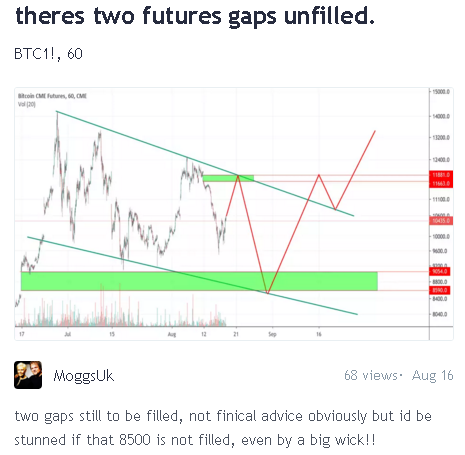There is an old trading maxim that veteran traders always abide by, which states that one should never let their emotions convince them that they are smarter than the market. We have all made this mistake. We develop a strategy around a perception of what we sincerely believe the market will do. We establish a position, and then watch for our “better-than-ever” strategy to pan out big time. But the market does not respond. It goes in the other direction. We remove our stop, feeling sure that the market will reverse, but it doe not. Losses mount, until we give up and say: “How could the market be so stupid!” A therapist would call that “projection”.
If you have been following the Bitcoin analyst community recently, you might have picked up on a similar type of hypothesis, one that claims that:
Gaps in the market are always filled at some time in the future.
Gaps can occur in active markets like the forex market, when events dictate a sudden shift, but, typically, gaps occur, especially in some futures markets, when the market is closed over a weekend. If the real market, as in Bitcoin. BTC trades over the weekend, then come Monday morning, the futures market may open well above or below its previous close, creating a “gap” in prices.
In this same vein, there has been a great deal of talk concerning a “gap” in the CME Bitcoin futures market. There are actually two, but the higher valued one will easily be “filled”, when BTC rises to the task. Of more concern is the gap around $8,300 to $8,800. Here is one example of an analyst postulating on TradingView that this lower gap must be filled:
Please excuse the grammar, but this hourly BTC chart has been annotated to include the CME gaps, as well as the analysts’ attempt to predict future price behavior. Their descending channel suggests future support and resistance points for their 5-legged impulse wave, right out of an Elliott Wave Theory textbook. The proposition does appear to be well thought out, based on sound technical underpinnings, but Bitcoin has consistently demonstrated that it tends to ignore technical tenets and do its own thing.
This hypothesis is by no means lame or “out-of-the-box” thinking. The “herd”, so to speak, has bought into this one, full line and sinker. We can almost hear the angry mutterings within the analyst community of, “How can the market be so stupid – when will it wise up and do what it is supposed to do?” On August 16th, Bitcoin was struggling to hold its position above $10,000, but since that low ebb, it has marched up the scale to $10,700, tracking the inserted “red” lined impulse wave, right on cue.
The hypothesis is creditable, but are we to accept it on faith? Bitcoin is still a very “young” market, with heavy concentrations in “whale” accounts. CME futures have been with us since December of 2017, once again relatively new, and we are also told that the predominant users of the hedging instruments tend to be exchanges in the global market place that are busy being “market makers” with their contingency of clients, a practice that does require position hedges to protect the downside and ensure the upside potential of the exchanges’ open positions.
During Bitcoin’s meteoric rise this year, many of the sudden vaults north have occurred over weekend trading, thereby suggesting that many run ups would naturally cause a few gaps along the way, since the CME is not open over the weekend for BTC futures trading. Even though BTC has only ten years on the books, seasonality trends favor a down movement, as well, as vacationing traders tend to be away from their desks. At this stage, betting on this notion is a coin toss, or as one analyst at Seekingalpha.com noted:
For the time being, a wait-and-see attitude at the sidelines is recommended.

